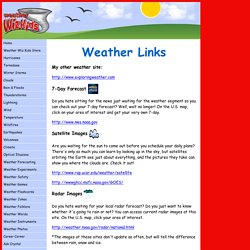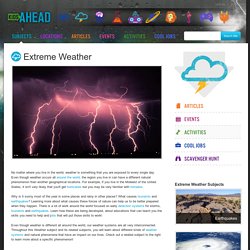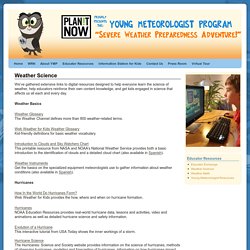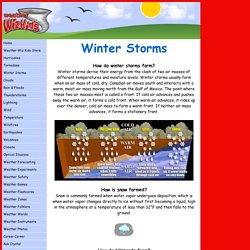

Kids Discover Online. Weather Wiz Kids weather information for kids. Weather Links My other weather site: 7-Day Forecast Do you hate sitting for the news just waiting for the weather segment so you can check out your 7-day forecast?

Well, wait no longer! On the U.S. map, click on your area of interest and get your very own 7-day. Satellite Images Are you waiting for the sun to come out before you schedule your daily plans? Radar Images Do you hate waiting for your local radar forecast? *The images at these sites don't update as often, but will tell the difference between rain, snow and ice. What is a blizzard? How Big do Tornadoes Get?
What is a Tornado? What Is A Hurricane? Hurricanes - En savoir plus sur les ouragans pour les enfants et les enfants. What Causes Thunder and Lightning? Weather and Climate: StudyJams! Science. Wild Weather Adventure! Search Results. Smithsonian Science Education Center. Note: The Adobe Flash plugin is needed to play this game on the web.

Please enable your Flash settings on your web browser. For issues with Google Chrome or Chromebook, please see Google Chrome Help. We recommend using another browser, such as Firefox, or downloading to a mobile device with the links below. The citizens of Smithsonville are in dire need of a Disaster Detector! Help Smithsonville and other cities predict and prepare for natural disasters. Disaster Detector teaches players how to analyze and interpret data on natural hazards to forecast future catastrophic events and how to implement tools to mitigate the effects of those disasters.
Frequently Asked Questions This game was funded under the Investing in Innovation (i3) validation grant (U396B100097) awarded to the Smithsonian Science Education Center (SSEC) by the U.S. Epic! - Read Amazing Children's Books - Unlimited Library Including Flat Stan... Subjects - Extreme Weather. No matter where you live in the world, weather is something that you are exposed to every single day.

Even though weather occurs all around the world, the region you live in can have a different natural phenomenon than another geographical locations. For example, if you live in the Midwest of the United States, it isn't very likely that you'll get hurricanes but you may be very familiar with tornados. Why is it sunny most of the year in some places and rainy in other places? What causes tsunamis and earthquakes? Learning more about what causes these forces of nature can help us to be better prepared when they happen. Because weather is awesome.
Weather And Climate. EnergyWeather And Climate The Brief Overview. Young Meteorologist. We’ve gathered extensive links to digital resources designed to help everyone learn the science of weather, help educators reinforce their own content knowledge, and get kids engaged in science that affects us all each and every day.

Weather Basics Weather Glossary The Weather Channel defines more than 800 weather-related terms. Web Weather for Kids Weather Glossary Kid-friendly definitions for basic weather vocabulary. Introduction to Clouds and Sky Watchers Chart This printable resource from NASA and NOAA’s National Weather Service provides both a basic introduction to the identification of clouds and a detailed cloud chart (also available in Spanish). Weather Instruments Get the basics on the specialized equipment meteorologists use to gather information about weather conditions (also available in Spanish). Hurricanes How In the World Do Hurricanes Form? Evolution of a Hurricane This interactive tutorial from USA Today shows the inner workings of a storm. Lightning Floods Tornadoes.
What are hurricanes, typhoons and tropical cyclones? What is a Tornado? Facts & Information. Welcome to Web Weather for Kids. Weather Facts for kids. Weather Wiz Kids weather information for kids. Winter StormsHow do winter storms form?

Winter storms derive their energy from the clash of two air masses of different temperatures and moisture levels. Winter storms usually form when an air mass of cold, dry, Canadian air moves south and interacts with a warm, moist air mass moving north from the Gulf of Mexico. The point where these two air masses meet is called a front. If cold air advances and pushes away the warm air, it forms a cold front. When warm air advances, it rides up over the denser, cold air mass to form a warm front. What Causes a Blizzard? Heavy snow, bitter cold, whipping winds … Winter storms are no picnic, but what is the official definition of a blizzard, and what causes them, anyway?

The National Weather Service defines a blizzard as any severe snowstorm that is accompanied by strong winds — at least 35 mph — resulting in low visibility. The defining factor of a blizzard is actually the strength of the wind, rather than the amount of snow. To qualify as a blizzard, the combination of wind and snow must reduce visibility to a quarter mile or less and last for at least three hours. Severe blizzards can reduce visibility to zero, making it difficult to see buildings or trees just a few yards away.
While blizzards often feature extreme cold and heavy snow, there are actually no temperature or snow depth requirements for a storm to qualify as a blizzard. Blizzards can be very dangerous. The Great Lakes region is especially lucky, because it is positioned to be hit by both types of storms.